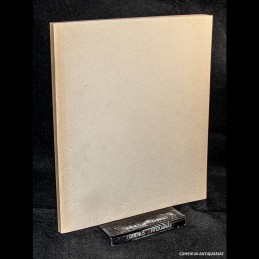Savelli, Angelo,
Padiglione d'arte contemporanea, 26 ottobre-25 novembre 1984. Savelli: five decades di Ned Rifkin. Milano: PAC, 1984. ca. 100 Seiten mit Abbildungen. Kartoniert (Klappenbroschur) mit Blindprägung. 4to. 358 g
* Italienisch und englisch. - Umschlag etwas lichtrandig / gebräunt.
Bestell-Nr.157824
Savelli |
Kunstausstellung |
Ausstellungskatalog
Savelli: Five decades
Angelo Savelli's artistic career spans five decades. From a very young age, ha was encouraged to draw by his uncle, Alfonso Barone. a sclftaugbt painter. Born in 1911 and raised in the small town of Pizzo Calabro. was fortunate that his father supported his artistic aspirations it\ sending him to Rome where, in only two years. Savelli completed the degree which normally, required four years to finish.
Subsequently, he gained entrance to home's Accademia di Belle Arti where lie learned the techniques of fresco and egg tempera painting. This traditional training served him well upon graduation from the kcadem% in 1936. He worked on fresco commissions immediat el% after leaving •ch4►ol. In 1940, he was offered a teaching job at the very lice() at \\ hi•h he had been a student four years before. Returning to Rome, he continued painting in the traditional stvle that had evolved entirely apart from the innovations of international \lodernism. After the trauma of the war subsided, Savelli was an active participant in the art scene in Rome. With Jarema. Seyerini, Fazzini. Guzzi. Nl►ntanarini and Tamburi. he was instrumental in founding the Art Club in 1945. While exposure to artists in other areas was still extremely limited. he began to understand intuitively that something was missing from his landscapes. cityscapes, and portraits. The "scuola romana" which A\ as reacting against the previous years of dominant official fascist art, was unable to establish a strong connection to the expressionist mode originated in German% decades earlier. Of the wellknown Italian art movements futurism v\ as the primary source of inspiration for Savelli. since most of the older. more established Italian artists returned to traditional sty les. (ink Giorgio Morandi and his monastic splendor held serious interest for the otinu Savelli and his cronies. One painting from this period, Tonle Carou• (104617) indicates the artist s desire to examine the vista in terms of interlocking planes. structured by an insistent linear containment. The use of angular planes in the - sky is really the seed of some of Savelli's most recent nom)bjectke \\ \t this time he had never been to Paris or New ork, hence he \\ as only aware of the protoeuhist works of Picasso and Braque t h rourrh repr►ductions. nor had he seen any of Lionel Feininger's elegant painting- and woodcuts of architectural edifices done at the Bauhaus in the k ( A major turning point in Savelli's art oecured in 1918. He \\ as avt arded grant to travel to Paris for one month. Instead. he managed to retch till_ to last nearly a year. The experience of the art lie encountered in Paris ‘s as a revelation for this young Italian painter. is he recounts. "I realized that I needed to liberate myself from the divine Italian tradition and find something to contribute to the historical continuum. He began at %\ hat he identifies as"Line' zero". a tabula rasa. b% emploN only lines in all of his work. Inspired by the cathedral of \loin. I )amc. both its architecture and its stained glass %\Savelli initiated a stunnitimetamorphosis. He understood more about his need to define a torn: ! vocabulary of his own. one that could respect his particular sensi►ilit%. but would respond to the experiments in forms and techniques that he ;1iset$- vered eN en- Ns here in Paris. Returning to Rome after nine months_ he found it increasi flak 1,, accomodate his friends* attitudes of dismay at his nekt MCI hod, and […]






 Datenschutz
Datenschutz
 Versandkosten
Versandkosten
 Google Mail
Google Mail
